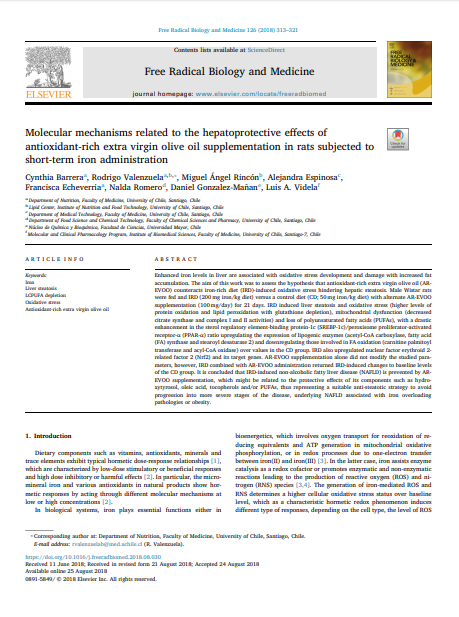Molecular mechanisms related to the hepatoprotective effects of antioxidant-rich extra virgin olive oil supplementation in rats subjected to short-term iron administration

Fecha
2018Autor
González-Manan, Daniel [Univ Mayor, Fac Ciencias, Nucleo Quim & Bioquim, Santiago, Chile]
Barrera, Cynthia
Valenzuela, Rodrigo
Angel Rincón, Miguel
Espinosa, Alejandra
Echeverria, Francisca
Romero, Nalda
Videla, Luis A.
Ubicación geográfica
Notas
HERRAMIENTAS
Acceda a títulos restringidos
¿Cómo descargar?Resumen
Enhanced iron levels in liver are associated with oxidative stress development and damage with increased fat accumulation. The aim of this work was to assess the hypothesis that antioxidant-rich extra virgin olive oil (AREVOO) counteracts iron-rich diet (IRD)-induced oxidative stress hindering hepatic steatosis. Male Wistar rats were fed and IRD (200 mg iron/kg diet) versus a control diet (CD; 50 mg iron/kg diet) with alternate AR-EVOO supplementation (100 mg/day) for 21 days. IRD induced liver steatosis and oxidative stress (higher levels of protein oxidation and lipid peroxidation with glutathione depletion), mitochondrial dysfunction (decreased citrate synthase and complex I and II activities) and loss of polyunsaturated fatty acids (PUFAs), with a drastic enhancement in the sterol regulatory element-binding protein-1c (SREBP-1c)/peroxisome proliferator-activated receptor-alpha (PPAR-alpha) ratio upregulating the expression of lipogenic enzymes (acetyl-CoA carboxylase, fatty acid (FA) synthase and stearoyl desaturase 2) and downregulating those involved in FA oxidation (carnitine palmitoyl transferase and acyl-CoA oxidase) over values in the CD group. IRD also upregulated nuclear factor erythroid 2-related factor 2 (Nrf2) and its target genes. AR-EVOO supplementation alone did not modify the studied parameters, however, IRD combined with AR-EVOO administration returned IRD-induced changes to baseline levels of the CD group. It is concluded that IRD-induced non-alcoholic fatty liver disease (NAFLD) is prevented by AREVOO supplementation, which might be related to the protective effects of its components such as hydroxytyrosol, oleic acid, tocopherols and/or PUFAs, thus representing a suitable anti-steatotic strategy to avoid progression into more severe stages of the disease, underlying NAFLD associated with iron overloading pathologies or obesity.
URI
https://doi.org/10.1016/j.freeradbiomed.2018.08.030http://repositorio.umayor.cl/xmlui/handle/sibum/6125
Coleccion/es a la/s que pertenece:
Si usted es autor(a) de este documento y NO desea que su publicación tenga acceso público en este repositorio, por favor complete el formulario aquí.